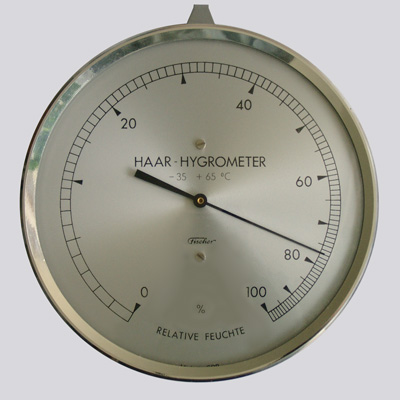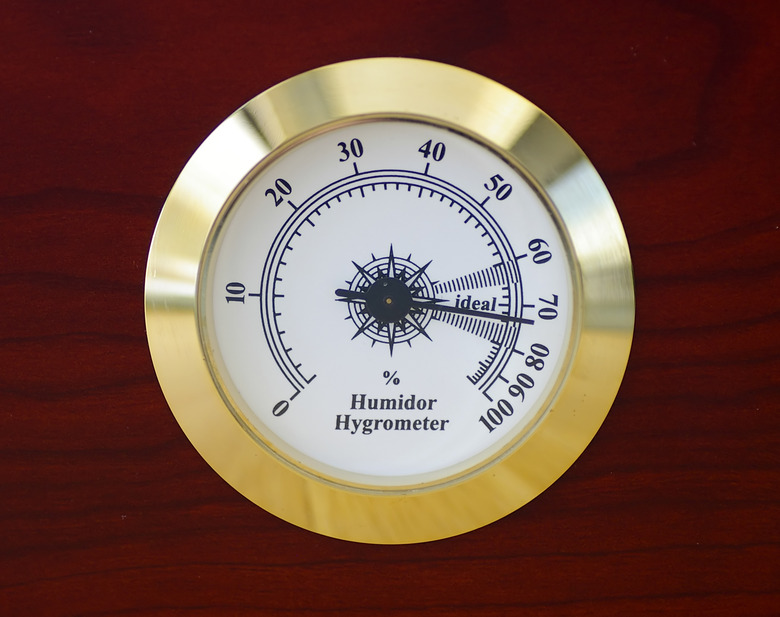Have you ever wondered why your home feels damp or why your skin gets dry and itchy? The answer might lie in the air around you, and a simple device called a hygrometer can tell you exactly what’s going on.
But what does a hygrometer measure, and why should you care? Understanding this can help you take control of your environment, protect your health, and even save your belongings from damage. Keep reading to discover how this small tool can make a big difference in your daily life.

Credit: en.wikipedia.org
Basics Of A Hygrometer
A hygrometer is a device that measures humidity. Humidity means the amount of water vapor in the air. This tool helps understand how wet or dry the air is around us. People use hygrometers in homes, greenhouses, and weather stations. Knowing humidity is important for comfort, health, and safety.
Hygrometers come in different types. Each type works in a unique way to measure moisture. They all aim to give clear information about the air’s humidity level.
Types Of Hygrometers
There are several types of hygrometers. The most common ones include mechanical, electronic, and dew point hygrometers. Mechanical hygrometers use materials that change size when wet. Electronic hygrometers measure changes in electrical resistance or capacitance. Dew point hygrometers find the temperature when air becomes saturated with water vapor. Each type suits different needs and environments.
How Hygrometers Work
Hygrometers work by detecting moisture levels in the air. Mechanical types use hair or paper that expands or contracts with humidity. Electronic types use sensors that react to water vapor. These sensors send data to a display showing humidity percentage. Dew point models cool a surface until dew forms, measuring moisture precisely. The readings help people control air quality and comfort.
Importance Of Measuring Humidity
Measuring humidity is crucial for many reasons. It affects health, home comfort, and various industries. Knowing humidity levels helps maintain a safe and comfortable environment. It also protects property and supports efficient industrial operations.
Impact On Health
Humidity influences breathing and skin health. Low humidity can cause dry skin and irritation. High humidity may increase allergy and asthma symptoms. Controlling humidity reduces the risk of mold and dust mites. This creates a healthier living space for everyone.
Effects On Home And Property
Humidity can damage wood, paint, and furniture. Too much moisture leads to mold growth and rot. Too little causes cracking and shrinking of materials. Measuring humidity helps protect your home’s structure and belongings. It keeps your space safe and comfortable.
Role In Industrial Processes
Many industries need precise humidity control. Electronics manufacturing relies on stable humidity to avoid damage. Food production requires certain moisture levels for quality and safety. Textile and paper industries depend on humidity for product consistency. Monitoring humidity ensures smooth and efficient operations.
Different Humidity Metrics
Humidity is not just one simple number. It has different ways to be measured. Each shows a unique part of moisture in the air. Understanding these helps explain what a hygrometer really measures.
These measurements give insight into comfort, weather, and even health. Let’s explore the main types of humidity metrics.
Relative Humidity
Relative humidity shows how much moisture is in the air compared to the most it can hold at a certain temperature. It is shown as a percentage. For example, 50% means the air holds half the moisture it could hold. This metric helps predict how dry or wet the air feels.
Absolute Humidity
Absolute humidity measures the actual amount of water vapor in the air. It is usually shown in grams of water per cubic meter of air. This number does not change with temperature. It tells you the true amount of moisture present at any time.
Dew Point
Dew point is the temperature at which air becomes fully saturated and water starts to form. It shows when moisture will begin to condense as dew. This metric helps predict fog, frost, and moisture on surfaces. It also indicates how humid the air feels.
Choosing The Right Hygrometer
Choosing the right hygrometer is important for accurate humidity readings. The right device helps keep your home, workplace, or storage area comfortable and safe. Many types of hygrometers exist, each with its own features and benefits. Understanding these options makes it easier to pick the best one for your needs.
Factors To Consider
First, think about where you will use the hygrometer. Some models work better indoors, others outdoors. Also, check the device’s accuracy and range of humidity it can measure. A good hygrometer should give reliable results in your environment. Size and design matter too. Small, portable models fit tight spaces. Bigger devices may have more features but take up more room.
Another factor is the price. Hygrometers come in many price points. Choose one that fits your budget but does not sacrifice quality. Some devices need batteries, while others do not. Battery life may affect how often you maintain the device. Look for models with clear displays for easy reading.
Digital Vs Analog Devices
Digital hygrometers show humidity on a screen in numbers. They often include extra features like temperature readings or memory storage. Digital models are usually easy to read and use. They may need batteries or charging to work.
Analog hygrometers use a needle and dial to show humidity. They do not need power sources. Some people prefer analog for its classic look and simple design. Analog devices may require calibration to stay accurate. They can be less precise than digital models but still work well for many uses.
Choose digital or analog based on your preferences and needs. Both types measure humidity but differ in features and ease of use. Consider how you want to read and maintain the device before deciding.
Using A Hygrometer Effectively
Using a hygrometer effectively helps you get accurate humidity readings. This tool can protect your home, plants, and health. Small steps make a big difference in its performance.
Placement Tips
Place your hygrometer in a spot with good air flow. Avoid direct sunlight or near heaters and air conditioners. These can cause false readings. Keep it away from windows and damp areas. A central location in the room works best. Check the device regularly for dust or dirt. Clean it gently to keep it working well.
Calibration Methods
Calibration keeps your hygrometer accurate over time. Use a simple salt test to check accuracy. Place the hygrometer in a sealed bag with a small container of salt and water. Wait eight hours, then check the reading. It should show 75% humidity. Adjust the device if possible, or note the difference. Regular calibration ensures reliable results.

Credit: qasupplies.com
Common Applications Of Hygrometers
Hygrometers are useful tools that measure moisture in the air. They help control humidity levels in many places. Knowing humidity is important for comfort, safety, and preserving items. Different fields use hygrometers in unique ways to keep environments stable and healthy.
Weather Forecasting
Meteorologists use hygrometers to track humidity outdoors. Humidity affects weather patterns and forecasts. Accurate readings help predict rain, fog, and storms. This information is vital for daily weather reports.
Hvac Systems
Heating and cooling systems rely on hygrometers to adjust air moisture. Proper humidity keeps homes and offices comfortable. It also prevents mold growth and damage to furniture. Hygrometers ensure the air stays healthy and balanced.
Agriculture
Farmers use hygrometers to monitor humidity in greenhouses and fields. Plants need specific moisture levels to grow well. Controlling humidity helps prevent diseases and boosts crop yields. It supports healthy plants and better harvests.
Museums And Archives
Museums use hygrometers to protect valuable artifacts and documents. High humidity can damage paper and paintings. Low humidity can cause materials to dry out and crack. Maintaining the right moisture level preserves history for future generations.

Credit: www.sciencing.com
Frequently Asked Questions
What Does A Hygrometer Measure Exactly?
A hygrometer measures the amount of moisture or humidity in the air. It helps track relative humidity levels for comfort and safety.
Why Is Measuring Humidity Important?
Humidity affects health, comfort, and property. Measuring it helps prevent mold, allergies, and damage to wood or electronics.
How Does A Digital Hygrometer Work?
A digital hygrometer uses sensors to detect moisture levels. It converts this data into a readable digital format instantly.
Can A Hygrometer Measure Indoor And Outdoor Humidity?
Yes, hygrometers can measure both indoor and outdoor humidity. Choosing the right type depends on your specific monitoring needs.
Conclusion
A hygrometer measures the amount of moisture in the air. This helps keep homes comfortable and safe. It also protects items sensitive to humidity. Many people use hygrometers to monitor weather and indoor air quality. Knowing humidity levels can prevent mold and damage.
It’s a simple tool with many useful uses. Understanding what a hygrometer measures helps you care for your space better. Small device, big impact.



